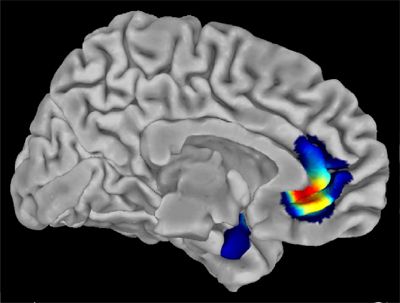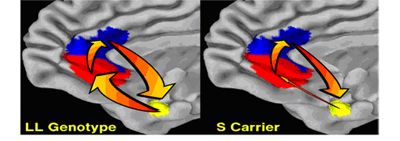Depression Gene May Weaken Mood-Regulating Circuit
A brain scan study suggests that a suspect gene may increase susceptibility to anxiety and depression,* by weakening a circuit for processing negative emotion.
A brain scan study suggests that a suspect gene may increase susceptibility to anxiety and depression,* by weakening a circuit for processing negative emotion. People with the depression-linked gene variant showed less gray matter and weaker connections in the mood-regulating circuit. How well the circuit was connected accounted for nearly 30 percent of their anxious temperament, researchers at the National Institute of Health's (NIH) National Institute of Mental Health (NIMH) found. Dr. Daniel Weinberger and colleagues report on their brain imaging genetics study in the May 8, 2005 online edition of Nature Neuroscience.
"We discovered the mood-regulating circuit by using the gene to interrogate the imaging data," explained Weinberger. "The brain handles information much like an orchestra. So we asked questions akin to ‘Are the violin and the clarinet playing the same tune and to what extent might this gene account for it?'"
In this case, it turned out that the amygdala, a fear processing hub deep in the brain and the cingulate, an emotion-dampening center located near the front of the brain, were playing a duet under the baton of the depression-linked gene.
The gene codes for the serotonin transporter, the protein in brain cells that recycles the chemical messenger after it's been secreted into the synapse, the gulf between cells. Since the most widely prescribed class of antidepressants act by blocking this protein, researchers have focused on possible functional consequences of a slight variation in its DNA sequence across individuals. Everyone inherits two copies of the gene, one from each parent, which comes in two common versions: short and long. The short version makes less protein, resulting in less recycling, increased levels of serotonin in the synapse, and more serotonin-triggered cellular activity. Previous NIMH-supported studies had shown that inheriting the short variant more than doubles risk of depression following life stresses,** boosts amygdala activity while viewing scary faces,*** and has been linked to anxious temperament. Yet, how it works at the level of brain circuitry remained a mystery.
The NIMH research team first scanned 114 healthy subjects using magnetic resonance imaging (MRI). Those with at least one copy of the short variant had less gray matter, neurons and their connections, in the amygdala-cingulate circuit than those with two copies of the long variant.
Next, using functional magnetic resonance imaging (fMRI), the researchers monitored the brain activity of 94 healthy participants while they were looking at scary faces, which activates fear circuitry. Those with the short variant showed less functional connectivity, in the same circuit.
Nearly 30 percent of subjects' scores on a standard scale of "harm avoidance," an inherited temperament trait associated with depression and anxiety, was explained by how well the mood-regulating circuit was connected.
"Until now, it's been hard to relate amygdala activity to temperament and genetic risk for depression," said Dr. Andreas Meyer-Lindenberg, a lead author. "This study suggests that the cingulate's ability to put the brakes on a runaway amygdala fear response depends upon the degree of connectivity in this circuit, which is influenced by the serotonin transporter gene."
Since serotonin activity plays a key role in wiring the brain's emotion processing circuitry during early development, the researchers propose that the short variant leads to stunted coupling in the circuit, a poorly regulated amygdala response and impaired emotional reactivity – resulting in increased vulnerability to persistent bad moods and eventually depression as life's stresses take their toll.
Other members of the NIMH team were: Dr. Lukas Pezawas, Dr. Bhaskar Kolachana, Dr. Michael Egan, Dr. Venakata Mattay, Emily Drabant, Beth Verchinski, and Karen Munoz. Dr. Ahmad Hariri, University of Pittsburgh, also participated in the study.
* Information on Depression from NIMH
** Gene More Than Doubles Risk of Depression Following Life Stresses
*** Gene May Bias Amygdala Response to Frightful Faces

Areas in the cingulate (right) and amygdala (left) that differed in gray matter volume between subjects with the short and long version version of the serotonin transporter gene. Short version carriers showed the greatest reductions in the red area, which previous studies have linked to depression.

Subjects with two copies of the long version (LL) of the serotonin transporter gene showed more functional connectivity between the amygdala (yellow) and the Cingulate (red, blue), which are key components of a mood-regulating circuit.
References:
Source: NIMH Clinical Brain Disorders Branch
NIMH is part of the National Institutes of Health (NIH), the Federal Government's primary agency for biomedical and behavioral research. NIH is a component of the U.S. Department of Health and Human Services
